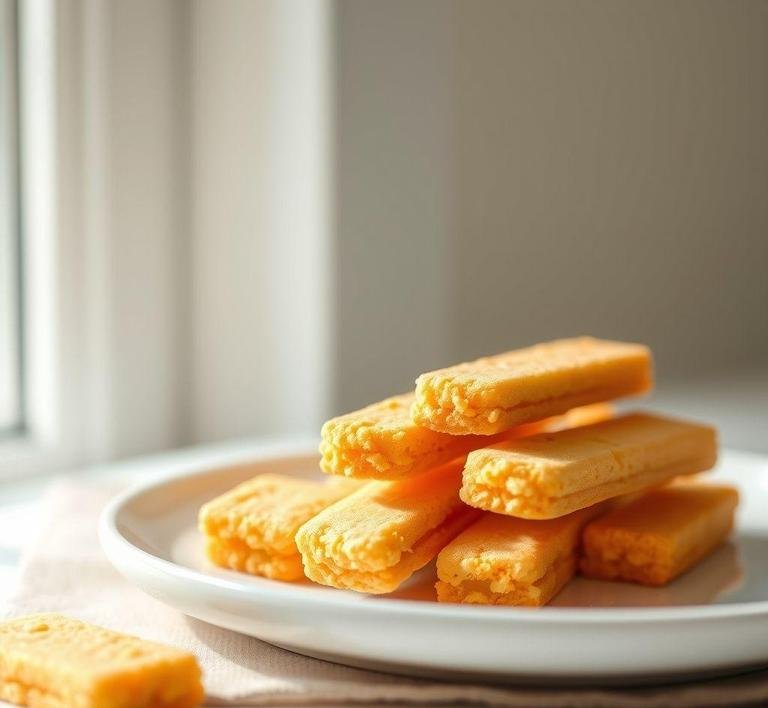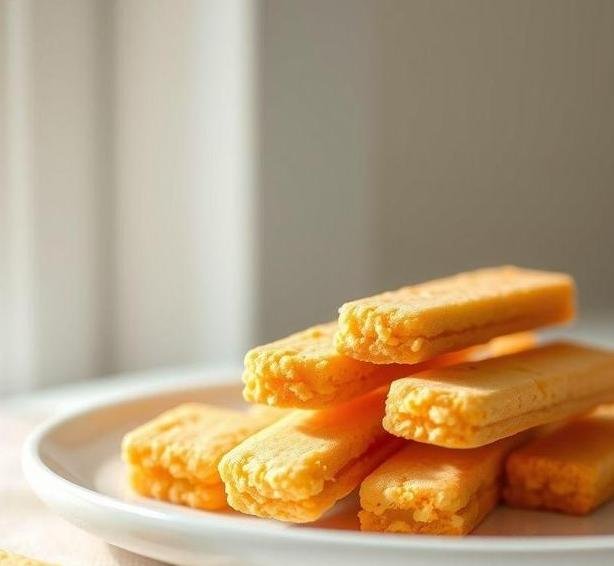Mary Berry’s Orange Shortbread Fingers are a beautifully simple yet exquisitely flavorful twist on traditional shortbread. Shortbread itself is known for its crumbly, melt-in-your-mouth texture, rich buttery flavor, and subtle sweetness. Mary Berry, a culinary icon famed for her classic British baking expertise, infuses this timeless biscuit with the fresh, zesty brightness of orange.
Imagine biting into a golden, buttery biscuit that gently crumbles with each bite, releasing delicate hints of orange zest that uplift the palate. These shortbread fingers are slender, elongated cookies, perfect for dipping into tea or coffee, or simply enjoyed on their own as a refined teatime treat. Their crisp edges and tender crumb are a testament to the perfect balance of butter and flour, with the citrus twist adding a modern, refreshing edge.
Mary’s recipe is celebrated for its precision and ease – no fancy ingredients or complicated techniques, just pure, honest baking that yields an elegant biscuit with a delightful orange aroma and flavor. Whether you’re an experienced baker or a curious novice, these orange shortbread fingers offer an approachable yet rewarding baking experience.
Mary Berry’s Orange Shortbread Fingers Recipe
Ingredients Needed

The magic of Mary Berry’s Orange Shortbread Fingers lies in the simplicity and quality of its ingredients. Each one plays a crucial role in building the biscuit’s tender texture and vibrant flavor:
- Unsalted Butter (Cold and Cubed): The star ingredient for shortbread, butter provides richness, moisture, and that irresistible melt-in-the-mouth texture. Using unsalted butter allows you to control the salt content precisely.
- Caster Sugar: This fine sugar dissolves quickly, blending seamlessly with the butter to create a smooth, sweet base without grittiness.
- Plain (All-Purpose) Flour: The foundation of the dough, plain flour gives the biscuit structure while keeping it delicate.
- Cornflour (Cornstarch): A key addition for shortbread, cornflour lightens the texture, ensuring a crumbly softness rather than a tough bite.
- Orange Zest: Freshly grated orange zest injects that unmistakable citrus fragrance and a subtle tang that elevates the classic shortbread flavor.
- A pinch of Salt: Enhances the sweetness and balances the richness, preventing the biscuits from tasting flat.
Optional but recommended: a light dusting of icing sugar on top for a delicate finish.
Equipment Needed
While the ingredient list is minimal, the right tools can make the baking process smoother and more enjoyable. Here’s what you’ll want on hand:
- Mixing Bowls: At least one large bowl for combining the dough ingredients comfortably.
- Grater or Zester: To zest the orange finely without including the bitter pith.
- Measuring Scales or Cups: Precision is key in baking, so use reliable scales or measuring tools.
- Wooden Spoon or Silicone Spatula: For mixing the dough without overworking it.
- Baking Sheet (Flat Tray): A flat, rimmed baking sheet to lay out your shortbread fingers for even baking.
- Parchment Paper or Silicone Baking Mat: Prevents sticking and makes cleanup effortless.
- Knife or Pastry Cutter: To shape and cut the dough into neat fingers.
- Cooling Rack: Essential for allowing the biscuits to cool evenly without sogginess.
Optional but helpful:
- Rolling Pin: If you prefer to roll out the dough evenly before cutting.
- Ruler or Straight Edge: To measure and cut uniform fingers.
Instructions To Make Mary Berry’s Orange Shortbread Fingers
Here’s the step-by-step journey from raw ingredients to irresistible orange shortbread fingers:
- Preheat the Oven: Start by preheating your oven to 160°C (320°F) for fan ovens or 180°C (350°F) for conventional ovens. This ensures a perfect, even bake.
- Prepare the Dough: In a large mixing bowl, cream together the cold, cubed unsalted butter and caster sugar. Use a wooden spoon or your fingertips to rub the mixture together until it resembles fine breadcrumbs – this delicate step is key to the perfect crumb.
- Add Dry Ingredients: Sift the plain flour and cornflour into the bowl. Add a pinch of salt and the freshly grated orange zest. Gently fold everything together using a spatula or your hands, bringing the mixture into a smooth, cohesive dough. Avoid over-kneading, which can make the shortbread tough.
- Shape the Dough: Turn the dough out onto a lightly floured surface. Roll or press it into a rough rectangle about 1cm (around ½ inch) thick. Using a sharp knife, cut the dough into finger-shaped strips approximately 1 cm wide and 7-8 cm long. Alternatively, you can shape them by hand for a rustic look.
- Arrange and Chill: Place the fingers neatly spaced on a parchment-lined baking tray. For a crisper edge, chill the shaped dough in the fridge for 10-15 minutes before baking.
- Bake: Slide the tray into the oven and bake for about 20-25 minutes. The fingers should be a pale golden color – keep a close eye to avoid over-browning, which can dry them out.
- Cool: Remove the shortbread fingers from the oven and transfer them carefully to a cooling rack. Let them cool completely before handling, as they firm up while cooling.
- Optional Finishing Touch: Once cool, dust lightly with icing sugar if desired for an elegant presentation.
Tips And Tricks
To help you achieve Mary Berry’s signature shortbread perfection, here are some insider tips:
- Butter Temperature Matters: Use cold butter and rub it in gently – this creates tiny pockets of butter that melt during baking, giving shortbread its characteristic crumbly texture.
- Zest Only the Orange Skin: Avoid the bitter white pith underneath. A microplane grater works wonders here for fine zest.
- Don’t Overwork the Dough: Shortbread dough should be handled as little as possible to keep it tender.
- Chill for Better Shape: Chilling helps the dough hold its shape during baking, preventing excessive spreading.
- Watch Your Bake Time: Shortbread can go from perfectly golden to burnt quickly, so start checking at the 20-minute mark.
- Storage: Keep the fingers in an airtight container once cooled. They stay fresh and crisp for up to a week, and their flavor even improves a bit over time.
- Pairing Suggestions: These orange shortbread fingers pair beautifully with a cup of Earl Grey tea, a fresh citrusy lemonade, or even a light dessert wine for a more indulgent treat.
Mary Berry’s Orange Shortbread Fingers are a timeless example of how simple ingredients, when combined with thoughtful technique, can produce a stunningly delicious treat. The buttery, crumbly texture married with the fresh zing of orange zest makes these biscuits both comforting and invigorating.
They are perfect for teatime, gifts, or whenever you need a little burst of joy wrapped in a delicate, golden biscuit. By following Mary Berry’s classic recipe, you tap into generations of baking wisdom, creating a homemade treat that’s sure to impress family, friends, and even yourself.
So why not gather your ingredients, dust off your baking tools, and embark on this delightful baking adventure? The fragrant aroma of orange shortbread wafting through your kitchen is more than just a promise of sweetness – it’s an invitation to slow down, savor, and celebrate the simple pleasures of good baking.
Easy Recipe Variations For Mary Berry’s Orange Shortbread Fingers

Mary Berry’s Orange Shortbread Fingers are a classic treat-delicately buttery, with a subtle zing from fresh orange zest that elevates the humble shortbread to something truly special. But here’s the fun part: this recipe is a fantastic canvas for variations. Whether you want to experiment with flavors, textures, or even dietary tweaks, the possibilities are endless and surprisingly simple.
1. Citrus Fusion:
While orange is the star, you can swap or combine other citrus fruits for a refreshing twist. Think lemon zest for a bright, sharp note, or grapefruit zest for a slightly bitter, complex flavor. Combining lemon and orange zest together creates a sophisticated, layered citrus profile that’s unexpectedly delightful.
2. Almond or Hazelnut Shortbread:
Adding ground nuts into the mix can introduce a lovely nutty richness and a slight crunch. Substitute about ¼ cup of the plain flour with finely ground almonds or hazelnuts. This not only deepens the flavor but also adds a subtle texture contrast to the smooth shortbread base.
3. Spiced Orange Shortbread:
For those who love a bit of warmth, consider adding spices. A pinch of cinnamon or nutmeg pairs beautifully with orange zest, evoking cozy autumn vibes. For an exotic touch, try a tiny dash of ground cardamom or ginger – these spices harmonize with citrus and bring a unique aromatic twist.
4. Chocolate-Dipped Fingers:
Once your shortbread fingers are baked and cooled, dip one end into melted dark or white chocolate. You could also sprinkle the chocolate-dipped ends with crushed pistachios, toasted coconut flakes, or even edible gold dust for an elegant finish. The chocolate adds richness and a luxurious feel to the humble biscuit.
5. Gluten-Free Variation:
Swap regular flour for a gluten-free blend, ensuring it’s a 1:1 substitute that’s suitable for baking. Almond or oat flour can work well here, though the texture might be a little different-more crumbly but just as delicious. To help with binding, you might want to add a teaspoon of xanthan gum.
6. Vegan Orange Shortbread:
Replace butter with a high-quality vegan margarine or coconut oil. For binding, a tablespoon of ground flaxseed mixed with 3 tablespoons of water (flax egg) can substitute eggs if the recipe calls for any. The orange zest will still shine, and the texture remains tender and crumbly.
The beauty of Mary Berry’s recipe lies in its simplicity-these subtle changes allow you to make it your own, keeping the essence of buttery, citrusy shortbread while adding personal flair.
Storing Leftovers
Shortbread fingers are famously good for keeping fresh, but like all baked goods, their lifespan depends on how you store them. The goal is to maintain that tender crumb and buttery richness while preventing them from going stale or absorbing moisture.
1. Room Temperature Storage:
Once completely cooled, store your shortbread fingers in an airtight container. A tin with a tight-fitting lid is ideal. Place a sheet of parchment paper between layers if stacking to avoid them sticking together. At room temperature, properly stored shortbread can last about 5 to 7 days. Avoid humid environments, as moisture is the enemy-it can make the biscuits soggy.
2. Refrigeration:
You can refrigerate shortbread to extend freshness, especially in warmer climates. Seal them tightly in an airtight container or wrap well in plastic wrap to prevent them from absorbing odors or moisture. When chilled, they can last up to two weeks, but be aware that refrigeration can sometimes change the texture slightly, making them a touch firmer. Let them come to room temperature before serving to soften the bite.
3. Freezing:
If you’ve made a large batch or want to keep some for longer, freezing is your best bet. Place the cooled shortbread fingers in a single layer on a baking sheet and freeze until solid. Then transfer them to a freezer-safe container or zip-lock bag with parchment paper layers between to prevent sticking. Frozen shortbread can last up to 3 months. To enjoy, thaw at room temperature for a couple of hours. They’ll taste as fresh as the day you baked them!
Tips For Storage
- Avoid storing near strong-smelling foods to prevent flavor contamination.
- Keep away from direct sunlight or heat sources, which can cause the butter to spoil or melt.
- If your shortbread loses crispness, a brief 5-minute reheat in a low oven (150°C/300°F) can restore a bit of that fresh-baked texture.
What To Eat With Mary Berry’s Orange Shortbread Fingers?
While these fingers are absolutely scrumptious on their own, pairing them thoughtfully can elevate the experience to something truly memorable. The orange zest in the shortbread lends itself beautifully to a range of accompaniments-from beverages to dips and even ice cream.
1. Classic Tea or Coffee:
The traditional accompaniment has to be a well-brewed cup of tea-Earl Grey or English Breakfast, with their strong, robust flavors, perfectly complement the buttery richness and citrus notes. Alternatively, a smooth, not-too-bitter coffee or a mild latte also pairs brilliantly.
2. Citrus-Infused Drinks:
Try serving your shortbread fingers with a citrusy herbal tea, such as chamomile with orange peel, or a zesty green tea. Even a sparkling orange or lemon soda can be a refreshing match, especially during warm weather.
3. Fresh Fruit and Cream:
Serve alongside a small bowl of freshly whipped cream or crème fraîche and a handful of fresh berries-raspberries, blueberries, or strawberries. The fresh tartness cuts through the richness of the biscuit, balancing each bite perfectly.
4. Ice Cream or Sorbet:
A scoop of vanilla ice cream or a tart sorbet (think blood orange, lemon, or mango) makes a fantastic dessert duo. The cool creaminess or tangy sorbet contrasts the crumbly texture and buttery orange flavor for a delicious mouthfeel.
5. Cheese Pairings:
For a surprising savory-sweet combo, try the shortbread fingers with a mild, creamy cheese such as ricotta or mascarpone, lightly sweetened with a drizzle of honey. This is a perfect way to turn your treat into an elegant afternoon snack or dessert.
6. Drizzled Honey or Marmalade:
A light drizzle of runny honey or a dollop of orange marmalade on the side can accentuate the citrus notes and add extra sweetness without overpowering the biscuit.
Conclusion
Mary Berry’s Orange Shortbread Fingers are a timeless treat, combining the classic buttery crumb of shortbread with the vibrant brightness of fresh orange zest. Their simplicity is what makes them so versatile and beloved. Whether you enjoy them plain, dipped in chocolate, or infused with spices and nuts, these fingers offer a delightful canvas for culinary creativity.
By understanding how to store them properly, you can savor their deliciousness over days or even weeks, making them perfect for sharing, gifting, or simply enjoying bit by bit with your favorite cup of tea. And when paired thoughtfully-with tea, fresh fruit, or ice cream-they transform from a humble biscuit to a sophisticated indulgence.
So next time you bake Mary Berry’s Orange Shortbread Fingers, think of it as your gateway to a world of flavor exploration, cozy moments, and joyful treats. Happy baking!
FAQs
What Makes Mary Berry’s Orange Shortbread Fingers Unique?
Mary Berry’s orange shortbread fingers are unique due to the perfect balance of buttery, crumbly shortbread combined with the refreshing zest of orange. The addition of orange zest elevates the flavor profile, giving a citrusy twist to the traditional shortbread recipe. The shortbread itself is tender yet crisp, making it a delightful treat with a cup of tea or coffee.
Can I Make Mary Berry’s Orange Shortbread Fingers Ahead Of Time?
Yes, you can make Mary Berry’s orange shortbread fingers ahead of time. In fact, the shortbread tends to improve in flavor as it sits for a day or two, allowing the orange zest to infuse more deeply into the dough. Once baked, you can store the shortbread in an airtight container at room temperature for up to a week. Alternatively, you can freeze the dough before baking, and bake them fresh when you’re ready.
What Can I Use If I Don’t Have Unsalted Butter For Mary Berry’s Orange Shortbread Fingers?
If you don’t have unsalted butter, you can substitute it with salted butter. However, you should reduce or omit any additional salt from the recipe to prevent the shortbread from becoming too salty. Using unsalted butter is ideal because it allows you to control the level of salt in the recipe, ensuring a perfectly balanced flavor.


